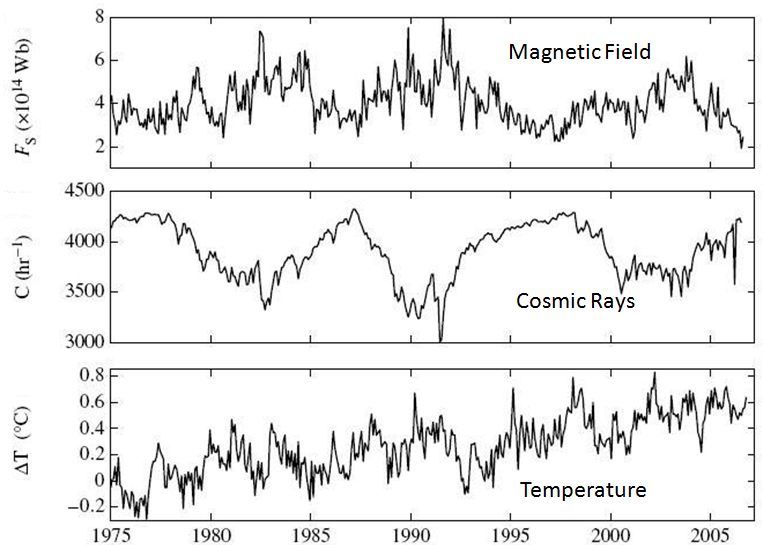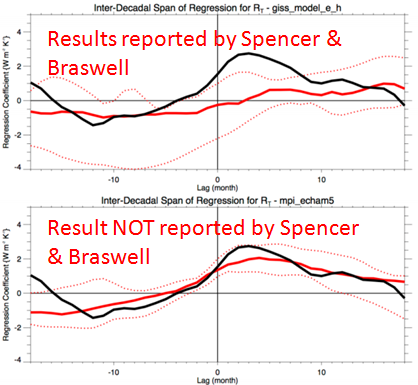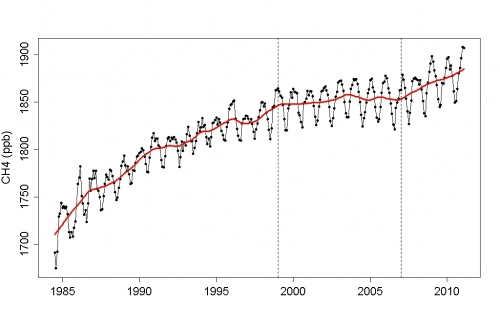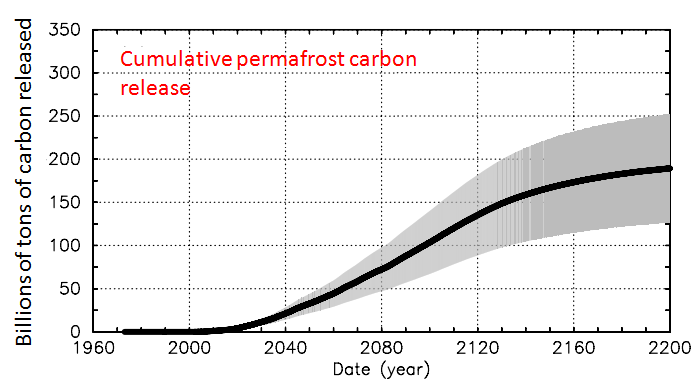 Figure 1 - Solar magnetic flux, cosmic rays arriving at Earth and Earth's temperature. The cosmic ray theory predicts a very small cooling, whilst temperatures rose. The cosmic rays measured can't have caused the warming (Lockwood & Frohlich, 2007).
Figure 1 - Solar magnetic flux, cosmic rays arriving at Earth and Earth's temperature. The cosmic ray theory predicts a very small cooling, whilst temperatures rose. The cosmic rays measured can't have caused the warming (Lockwood & Frohlich, 2007).This is the second part of a two-part article summarizing what we learned about climate change and climate science during 2011. In Part 1 we explored 2011's harvest of climate data. It's now possible for anyone reading this to see the measurements showing that the atmosphere and oceans are warming, that ice is melting and the seas are rising. 2011 saw some criticisms of the temperature record put to the test and it turned out to be a triumphant year for the scientists who'd measured and reported global warming. Now we'll explore a few of the more cutting edge parts of climate science in 2011.
Some species are very sensitive to environmental change, and can even die because of it. For example, small warming can 'bleach' and kill corals, and mass bleachings were observed in 1998, 2005 and 2010 as discussed by Rob Painting here.
If the warming is slow enough, then creatures and plants can migrate, often upwards or polewards. This has been seen (e.g. Nicolas et al, 2011 ; Kiritani, 2011 ; Yamano, et al 2011), and now Chen et al (2011) have shown that faster warming means faster migration, showing that the warming-migration link is solid. However, there is a limit to how quickly plants and animals can move, and those that can't keep up, or are already at their limits could become extinct (Malcolm et al, 2011).
We know that the Sun has caused big climate changes before but for the past decades of global warming the Sun has, if anything, cooled. Some scientists have suggested that the Sun can affect climate in more roundabout ways, such as the 'Galactic Cosmic Ray' (GCR) hypothesis. A quiet Sun has a weak magnetic field, which means more high energy particles from space, GCRs, reach Earth and make ions in the atmosphere which might make more cooling clouds. When the Sun is active, the opposite is expected.
For the past 30 years though, cosmic ray & the solar magnetic field have been flat (Lockwood & Frohlich, 2007).
 Figure 1 - Solar magnetic flux, cosmic rays arriving at Earth and Earth's temperature. The cosmic ray theory predicts a very small cooling, whilst temperatures rose. The cosmic rays measured can't have caused the warming (Lockwood & Frohlich, 2007).
Figure 1 - Solar magnetic flux, cosmic rays arriving at Earth and Earth's temperature. The cosmic ray theory predicts a very small cooling, whilst temperatures rose. The cosmic rays measured can't have caused the warming (Lockwood & Frohlich, 2007).
The theory predicts more clouds near nuclear tests, but they aren't seen. It predicts that the effect should also vary with latitude thanks to the Earth's magnetic field, but it doesn't. It predicts certain changes with height in the atmosphere, but the opposite occurs (see summary here). Erlykin & Wolfendale, 2011 showed again that <1% of low cloud cover has possibly correlated with GCRs. Laken and ?alogovi?, (2011) looked at daily data and found no evidence of a GCR effect whilst Agee et al (2011) found that clouds acted, this solar minimum, in the opposite way to the theory's predictions.
Repeated contradiction with experiments makes scientists revise or reject a theory. However, journalists and opinion columnists announced that global warming is caused by GCRs thanks to new results from CERN, Europe's nuclear physics lab (Kirkby et al, 2011). Skeptical Science discussed them at the time and came to the same conclusion as the lead scientist, Jasper Kirkby, who stated:
At the moment, it actually says nothing about a possible cosmic-ray effect on clouds and climate, but it's a very important first step
There's more to do on this fascinating theory, but we've known for years that it can't explain recent global warming.
Basic physics explains global warming from carbon dioxoide, but the Earth will change as it warms and has 'feedbacks' that can reinforce or suppress this warming. The 3 most well known are (Soden & Held, 2006)
Multiple lines of evidence suggest that these effects will double, treble or possibly even quadruple the effect of CO2 on its own (Knutti & Hegerl, 2008). That's a big range of possible warming, and more real world measurements are required to calculate how much each feedback contributes.
Satellite measurements of the Northern Hemisphere show that so far the retreat of snow and ice has been happening more than twice as quickly as computer simulations expected, as discussed here (Flanner et al, 2011).
The water cycle is harder to measure, but best estimates generally determined that atmospheric water vapour was increasing as predicted (Dessler, 2010). Trenberth, 2011 updated our knowledge, finding no evidence of a surprise cooling effect, but an expected increase in the atmospheric water vapour greenhouse effect. We also expect wet areas to get wetter, dry ones to get dryer and heavy rain and snowfalls to get heavier (supported by Seager et al 2011).
Climate models generally predict that cloud changes strengthen global warming, and past temperature changes match this result (Knutti & Hegerl, 2008). Studies using satellite data have usually found the same thing (Dessler, 2010 ; Lauer et al, 2010 ; Chung et al 2010 ; Chang & Coakley, 2007 ; Aitzen et al, 2008), but a handful of scientists have proposed that clouds slow global warming.
Richard Lindzen proposed in 2001 that a cooling 'cloud iris' would open over the Pacific and now Dana has provided a great summary of its experimental failures since then. Lindzen remained convinced that clouds would cool us down, but his 2009 results were shown by Trenberth et al (2010) to come from ignoring a good portion of the planet, ignoring a part of physics and making some other weird data choices that coincidentally all led to a cooling-cloud calculation.
Roy Spencer proposes that natural cycles change clouds which then cause warming so that it looks like global warming is causing the cloud change (Spencer & Braswell, 2011). Spencer & Braswell reported that several climate models don't properly simulate the pattern of cloud changes very well, and concluded that the difference was caused by models calculating too much global warming and that current observation methods could be hiding natural changes.
The paper was touted by political think tanks as support for their anti-climate change agenda, but was soon found to contain errors (Trenberth et al, 2011) causing the editor of the journal to resign because he thought the paper shouldn't have been published.

Figure 2 - Satellite measurements (black) and average model runs (red solid lines), including the range of model outputs (red dotted lines) for the relationship between clouds and temperature from 2 models. The top model results were reported by Spencer and Braswell but the bottom ones weren't shown. Spencer & Braswell also chose to ignore the range of model results and only reported the solid lines.
Spencer & Braswell ignored the range of model outputs, as Spencer later accepted on his blog. They also proposed that because the 6 models they chose showed a weak pattern supporting their hypothesis, that clouds suppressed global warming. However, a model that does a better job than those 6 was not reported, and that model says that clouds reinforce global warming, contrary to Spencer's claims.
Spencer & Braswell's claims of clouds suppressing global warming are not supported by the data once you include the values they didn't report. Their hypothesis of currently invisible natural cycles could be true, although the other lines of evidence currently support the mainsteam theory (Knutti & Hegerl, 2008 ; Lauer et al, 2010). They did demonstrate that several older models do a poor job in some respects, but these models are now 5 years old and their has been progress since then. Clouds remain an open question and despite the other evidence to the contrary, Spencer remains certain that he's right.
Scientists generally expect that nature's ability to 'soak up' carbon will get damaged as temperatures rise, although this doesn't seem to have happened for CO2 yet (Knorr, 2009). However, after years of stability atmospheric methane is on the rise once again and damage to wetlands (Sussman et al, 2011) and permafrost (O'Connor et al, 2010) caused by drying and warming could be to blame. Aircraft measurements in Canada have now shown that warming is directly linked to wetland carbon emissions (Pickett-Heaps et al, 2011).
 Figure 3 - After years of stability the amount of atmospheric methane, a potent greenhouse gas, has started increasing again. Graph courtesy of Tamino.
Figure 3 - After years of stability the amount of atmospheric methane, a potent greenhouse gas, has started increasing again. Graph courtesy of Tamino.
The sleeping giant of the carbon cycle is frozen ground called permafrost. As temperatures rise the ice melts and huge carbon stores could be released. Methane is already bubbling to the surface at frozen lakes in Siberia (Walter et al, 2006) and Alaska (Walter et al, 2007). 2011 computer simulations estimate a release of 100 billion tons of carbon by 2100 (Schaefer et al, 2011): 12 years worth of human fossil fuel burning. If just a few percent is methane, the heating effect would be doubled.

Figure 4 - Simulated cumulative carbon release by permafrost thanks to warming. The release is affected by how much fossil fuel humans burn and the global warming caused by that.
These computer simulations don't yet include some processes, such as abrupt thaws that lead to 'drunken forests'. Based on a survey of 41 experts, Schuur & Abbott, 2011 estimated that the results of computer simulations need to be increased by at least 70% to be realistic.
The Arctic is expected to become warmer than it has been for hundreds of millennia, so we can't easily use past performance as a guide to the future permafrost response like we have for the other feedbacks. If this effect is big, then the Earth will eventually warm much more than reported by the Intergovernmental Panel on Climate Change in 2007.
Finally, we know that thawing permafrost is not just levelling hillsides and tilting forests, but it's changing the world map: Wobus et al (2011) used repeated photographs to calculate that some Arctic shorelines are being worn away at a rate of 10-15 metres per year. Whilst winds are important, the erosion is 'mainly thermally driven'.
2011 has told us that animals and plants are convinced about global warming and have moved in response. We've also discovered that the cryosphere has been shrinking more quickly than models had expected and that the water cycle seems to be changing as predicted.
We were already confident that Galactic Cosmic Rays (GCRs) didn't cause recent warming, but CERN is exploring what they could do and this story isn't finished. Another unfinished, but scary, story is the carbon cycle and how much will it reinforce global warming.
2011 had two good outcomes. Most research suggests that clouds reinforce global warming but work by Spencer, despite its flaws, suggests that some methodologies aren't good enough for us to be certain. Spencer's speculation stretches credulity and runs counter to palaeoclimate evidence, but it's the most believable way we could avoid serious global warming. I want to believe it, it's just not well supported by the evidence.
The other good news is outside climate science: solar panel prices are dropping and fell 30% this year alone, so it will be cheaper to slow down global warming. Unlike Spencer's speculations this is definitely real.
Posted by MarkR on Tuesday, 10 January, 2012
 |
The Skeptical Science website by Skeptical Science is licensed under a Creative Commons Attribution 3.0 Unported License. |